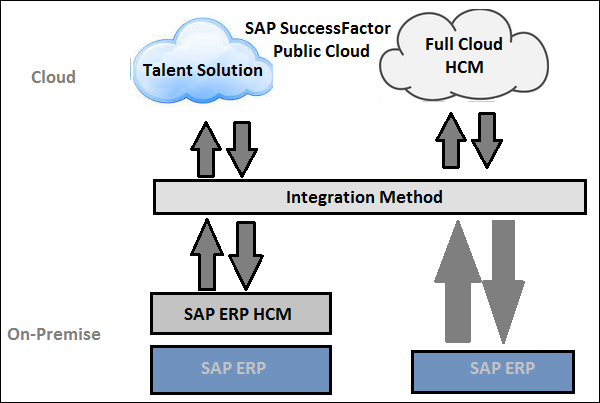SAP SuccessFactors is a leading cloud-based Human Capital Management (HCM) solution, and its architecture is specifically designed to offer flexibility, scalability, and seamless integration with existing enterprise systems. The image referenced showcases how the architecture bridges various components—cloud and on-premise systems—while ensuring optimal functionality for HR processes. Let’s break SAP SuccessFactors Architecture down for a thorough understanding.
Core Layers of the SAP SuccessFactors Architecture
- Cloud Layer
- This layer represents the core of SAP SuccessFactors’ cloud capabilities and includes two main components:
- a. Talent Solutions (Public Cloud):
This part of the architecture is designed for handling talent management. It includes modules like Recruiting, Onboarding, Performance & Goals, Succession Planning, and Learning. These functionalities reside in the cloud and are accessible via a web interface or mobile application. The public cloud ensures scalability and provides regular updates without the need for additional user intervention.- b. Full Cloud HCM:
For organizations looking to shift entirely to the cloud, the Full Cloud HCM option provides a complete suite of HR solutions. This includes everything from core HR operations (Employee Central) to advanced features like payroll, time management, and workforce analytics. Businesses adopting this approach eliminate the need for on-premise infrastructure while benefiting from a unified and integrated cloud platform.
- b. Full Cloud HCM:
- a. Talent Solutions (Public Cloud):

- Integration Layer
- This layer acts as the bridge between the cloud-based SAP SuccessFactors solutions and on-premise systems. Integration ensures seamless data flow and process synchronization across platforms. There are multiple methods to enable integration, such as:
- SAP Cloud Platform Integration (CPI): A middleware solution for connecting SuccessFactors with other SAP and non-SAP systems.APIs: These enable direct communication between SuccessFactors and third-party systems for specific use cases.Pre-Packaged Integration Content: SAP provides ready-made templates and integration packages to accelerate deployment.
- On-Premise Layer
- The on-premise layer focuses on organizations with existing SAP ERP systems. It typically includes: a. SAP ERP HCM:
SAP ERP Human Capital Management (HCM) handles traditional HR processes like personnel administration, payroll, and time management. While many businesses still rely on SAP ERP HCM for core HR functionalities, they often integrate it with SuccessFactors to enhance their talent management capabilities. b. SAP ERP Core:
The core ERP system connects various enterprise functions, such as finance, logistics, and procurement. SuccessFactors integrates with this layer to ensure HR data is synchronized across the organization, improving decision-making and operational efficiency.
Key Advantages of the Architecture
- Hybrid Model Support:
SAP SuccessFactors supports both hybrid and full-cloud models, making it adaptable to an organization’s unique needs. Businesses can choose to retain certain processes on-premise while utilizing advanced cloud features for talent management. - Scalability and Flexibility:
The cloud-based design ensures the architecture can scale with business growth. Organizations can start with a single module and expand as their requirements evolve. - Enhanced User Experience:
With a user-friendly interface and mobile accessibility, employees and managers can engage with HR processes anytime, anywhere. This fosters a more connected and productive workforce. - Seamless Data Integration:
The architecture ensures real-time data exchange between cloud and on-premise systems, enabling accurate payroll processing, workforce planning, and compliance reporting.
Advanced Features in the Architecture
- Metadata Framework (MDF):
The MDF enables businesses to customize the data model, workflows, and UI components without extensive coding. This framework supports the creation of unique solutions tailored to organizational requirements. - Intelligent Services:
These are event-based mechanisms that automate and streamline complex HR processes. For example, when an employee is promoted, the system can automatically trigger notifications, update permissions, and adjust payroll configurations. - Integration Center:
The Integration Center allows HR teams to build, monitor, and manage integrations without heavy reliance on IT teams. This tool simplifies the connection between SuccessFactors and other enterprise systems. - Analytics and Reporting:
SAP SuccessFactors comes with embedded analytics tools that help organizations track KPIs, monitor employee performance, and predict future trends using AI and machine learning.
Data Privacy and Security
SAP SuccessFactors architecture prioritizes data security and compliance with global standards like GDPR. It offers features such as data encryption, user access control, and audit logs to ensure sensitive HR data is protected.
Conclusion
The architecture of SAP SuccessFactors is thoughtfully designed to cater to businesses at various stages of digital transformation. Whether through its talent-focused solutions, full-cloud HCM capabilities, or robust integration with on-premise systems, it provides a scalable and secure platform for managing HR processes effectively. This architecture ensures that organizations can optimize their workforce while aligning HR functions with overall business strategies.
